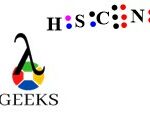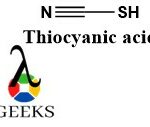HSCN lewis structure or thiocyanic acid is an important compound with usages in both organic and inorganic chemistry. Its properties chemically and electronically are described in this article.
HSCN lewis structure is a molecule composed of hydrogen, sulfur, carbon, and nitrogen. Here there is sharing of electrons . The sharing happens in such a way that there is the formation of triple covalent bonded cyanide ions and the rest of the sharing is single covalent bonding.
HSCN lewis structure or thiocyanic acid is a strong inorganic compound with usages in both specializations of chemistry. It is a hydracid with the sulfur atom. Another name for HSCN lewis structure is Hydrogen rhodanide. Discussing its composition then HSCN lewis structure is a colorless liquid. The HSCN lewis structure vapors are heavier than air.
Another important property of the HSCN lewis structure is that it can exist in the form of tautomers. It shows tautomerism with HNCS. Both of these structures exist in equilibrium where the isoform has more percentage existence in the vapor phase. The presence of a triple bond in the HSCN lewis structure is evident because of spectroscopic studies.
The complete information about the HSCN lewis structure can be understood from its structure formation and the behavior it exhibits which are listed below.
- How to draw the HSCN lewis structure?
- HSCN lewis structure resonance
- HSCN lewis structure shape
- HSCN lewis structure formal charge
- HSCN lewis structure angle
- HSCN lewis structure octet rule
- HSCN lewis structure lone pair
- HSCN lewis structure valence electrons
- HSCN lewis structure hybridisation
- HSCN lewis structure solubility
- Is HSCN lewis structure soluble in water?
- Is HSCN lewis structure a strong acid?
- Is HSCN lewis structure polar or nonpolar?
How to draw the HSCN lewis structure?
For completion of the HSCN lewis structure certain steps are followed which leads to its electron distribution. These steps are discussed in a stepwise manner.

Step1: Counting the number of valence electrons
HSCN lewis structure as the formula suggests has hydrogen, sulfur, carbon, and nitrogen atoms. All of these atoms have 1, 6, 4, and 5 valence electrons.
So the total number of electrons participating in the bond formation are 1 + 6 + 4 + 5 = 16.
Step 2: Determining the central atom
It is known that for proper electronic distribution in the HSCN lewis structure it is important to look out for the central atom with the least electronegativity.
Among all the atoms of the HSCN lewis structure Carbon is the least electronegative element. So in the HSCN lewis structure carbon will be the central atom and the rest of the atoms will surround it.
Step3: Bonding in the atoms of HSCN lewis structure
After setting up the background for determining the HSCN lewis structure by determining the central atom and the number of electrons involved.
Now we can begin the arrangement of the atoms according to the octet rule where the central carbon will form a triple covalent bond with nitrogen and a single covalent bond with sulfur.
Similarly sulfur will form another single covalent bond with hydrogen. Hence the stability of all the atoms and the stability criteria is complete.
Step4: Checking the formal charge
In the case of the HSCN lewis structure, the formal charge calculation confirms the existence and the presence of the structural formation.
Here all the atoms have zero formal charges which confirms the authenticity of the HSCN lewis structure.
HSCN lewis structure resonance
HSCN lewis structure is a strong acid and it can form canonical structures explaining different properties related to the structure. The presence of a triple bond in the structure and the lone pair of electrons also helps in delocalization.
Its conjugate base SCN- shows resonance stabilization because of its high pKa value. The resonance structure of the HSCN lewis structure can be explained diagrammatically.
HSCN lewis structure shape
HSCN lewis structure has a similar shape and molecular geometry due to its electron dot symbol arrangement. According to that HSCN lewis structure have a linear shape.
It follows the AX2 notion and has an arrangement in a straight line all evidence of its linearity.

HSCN lewis structure formal charge
Formal charge calculation is the uniform electronic distribution of the charge in the HSCN lewis structure. For every atom involved in the HSCN lewis structure, the formal charge should be minimal or zero. It can be calculated by:
FC = Valence electrons – Non bonding electrons – Bonding electrons/2
FC of S in HSCN lewis structure = 6 – 4 – 4/2 = 0
FC of C in HSCN lewis structure = 4 – 4 – 0/2 = 0
FC of N in HSCN lewis structure = 5 – 2 – 6/2 = 0
FC of H in HSCN lewis structure = 1 – 0 – 2/2 = 0
HSCN lewis structure angle
The bond angle of any structure can be easily determined from its molecular geometry or shape.
As far as the HSCN lewis structure is concerned then it has a linear shape and geometry which implies that its bond angle is 180 degrees.
HSCN lewis structure octet rule
HSCN lewis structure follows the octet rule stability as represented by its electron dot structural representation. Carbon is the central atom with 4 valence electrons and needs 4 more to complete the criteria.
So it shares its 3 electrons with nitrogen and the other one with sulfur thereby completing the octet for both itself and nitrogen.
Sulfur on the other hand needs 2 electrons to complete 8 electrons in its valence shell. It has already shared its 1 electron with carbon and the other one will be shared with hydrogen thereby completing its octet and the hydrogen’s duplet criteria.

HSCN lewis structure lone pair
Discussion of the lone pair of electrons in the HSCN lewis structure involves the lone pair of electrons of the central atom. In the HSCN lewis structure, the central atom is the carbon atom due to its low electronegativity.
The lone pair of electrons on the carbon atoms is zero as the 4 valence electrons of the carbon atom are shared from both sides i.e. triple covalent bond formation is on the nitrogen side and the single covalent bond formation is on the sulfur side.
Hence HSCN lewis structure has 0 lone pair of electrons.
HSCN lewis structure valence electrons
Valence electrons in the HSCN lewis structure are the concatenation of all the valence electrons present in the individual atoms. There is the presence of hydrogen, sulfur, carbon, and nitrogen which according to the periodic table has 1, 6, 4, and 5 valence electrons respectively.
So the total valence electron count in the HSCN lewis structure is 16 valence electrons.
HSCN lewis structure hybridisation
Determination of HSCN lewis structure hybridization is possible if we count the lone pair of electrons and the bonding electrons to the central atom.
Carbon is the central atom with no lone pair of electrons which implies that three are two electron density regions. Hence the hybridization of the HSCN lewis structure is sp.
HSCN lewis structure solubility
Thiocyanic acid or HSCN lewis structure is soluble in a varied range of solvents ranging from inorganic to organic. Due to its structural composition and applications in both organic and inorganic methodologies, its solubility domain has widened.
It is soluble in an aqueous medium and water. Also, it has shown solubility in organic solvents like diethyl ether and ethanol.
Is HSCN lewis structure soluble in water?
Yes, the HSCN lewis structure is soluble in water. It is an acid that in the presence of an aqueous medium or water dissociates into hydrogen and thiocyanate ions. Hence HSCN lewis structure is soluble in water.
Is HSCN lewis structure a strong acid?
HSCN lewis structure is a considerably strong acid and for that reason, it is categorized under inorganic acid despite having a role in organic synthetic methodologies.
The reason it is considered a strong acid is because it can completely dissociate in an aqueous medium, unlike organic acid which exhibits partial dissociation.
Also, its pka value is 1.1 at 20 degrees celsius with extrapolation to 0 ionic strength which is technical evidence of its strong acidity.
Is HSCN lewis structure polar or nonpolar?
HSCN lewis structure is a polar compound because it has hydrogen on one side which has a partial positive charge and nitrogen on the other side which has a partial negative charge.
Also, it is an unsymmetrical compound so it has a net dipole moment. Hence HSCN lewis structure is a polar covalent compound.
Conclusion
In nutshell, thiocyanic acid is a compound that belongs to both classes of chemistry i.e. organic and inorganic. Also, it is a strong acid and polar compound with a 100% covalent character and sshows the property of tautomerism where it is in equilibrium with isothiocyanic acid.
Also Read:
- Mg3n2 lewis structure
- Xeo2 lewis structure
- Socl2 lewis structure
- Sp3 lewis structure
- Xeo3 lewis structure
- Bacl2 lewis structure
- Brf4 lewis structure
- Ibr3 lewis structure
- Cos lewis structure
- K2co3 lewis structure

Hello, I am Mansi Sharma, I have completed my master’s in Chemistry. I personally believe that learning is more enthusiastic when learnt with creativity. I am a Subject Matter Expert in Chemistry.
Let’s connect through LinkedIn: https://www.linkedin.com/in/mansi-sharma22